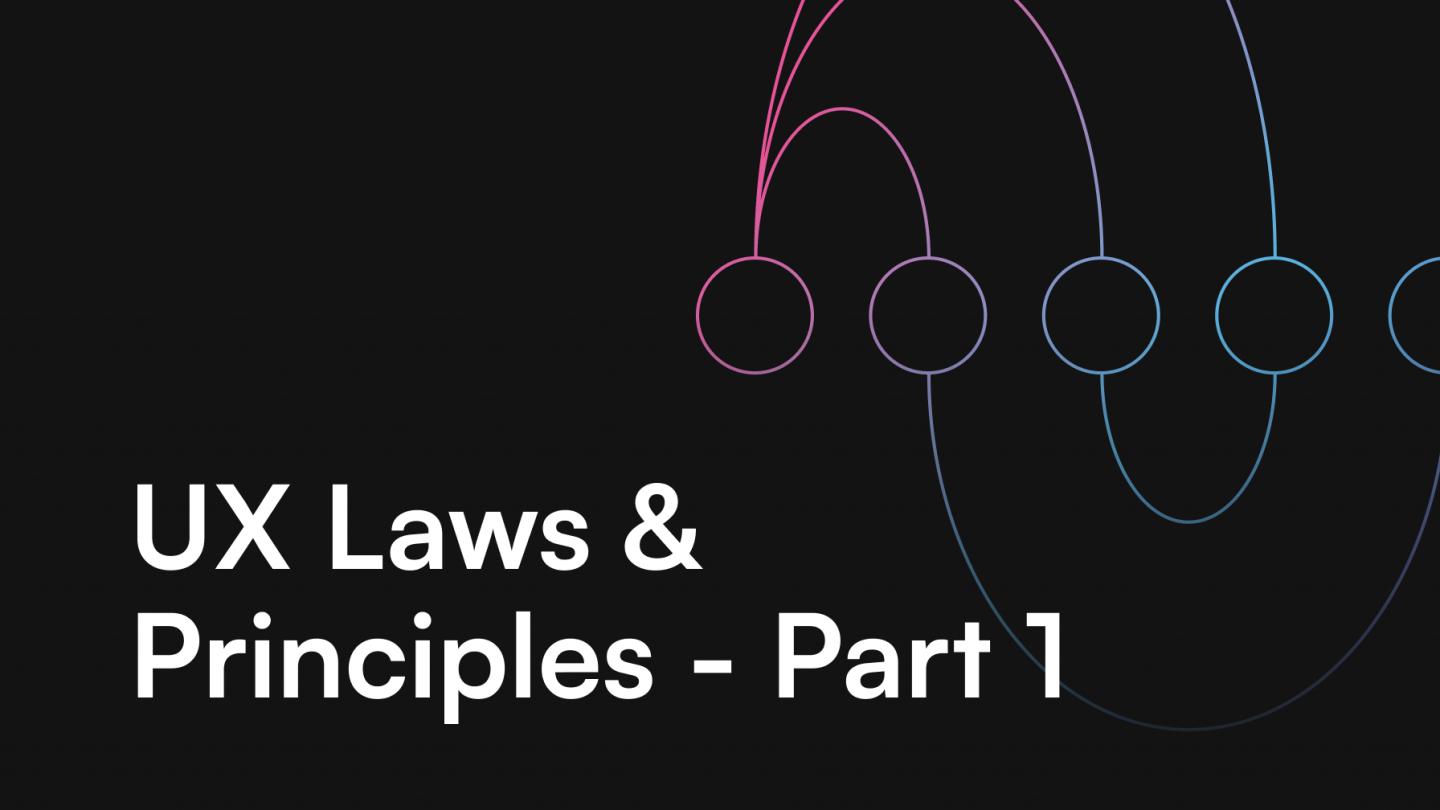UX Laws & Principles – Part 1

Jarosław Buczkowski

There are several rules that you must understand in order to master user experience design. UX Laws, also known as User Experience Principles, are a set of standards that designers may utilize to develop more user-centric and usable interfaces. The UX Laws are “blueprints” for how we see and process the environment around us.
Some principles have been around for a long time, while others are very new. Surprisingly, these usability and psychology concepts are still applicable in today’s environment and technology. These regulations are thoroughly documented on Jon Yablonski’s wonderful website, Laws of UX.
In this article, I’ll go through some of the key and my favourite UX rules, and how you leverage them to build a fantastic user experience. So, let’s go!

Law of Proximity
“Objects placed in proximity to one another will be seen as a group rather than as individual parts.”
The law of proximity explains how connections between visual elements are perceived by the human eye. Comparing adjacent elements to those that are distant from one another, adjacent elements are perceived as being related.
Proximity helps users understand and organize information faster and more efficiently.
People can group ideas, concepts, etc. using the law of proximity, which makes it ideal for us to be able to spot various clusters of objects quickly. However, as designers, we must exercise caution when incorporating legal principles into our designs. Why? A crowded, noisy layout will result from grouping too many items too closely. Your design will become meaningless because the distances between each item will be so blurry.
The distance between text blocks indicates how likely it is that they are connected. Browse any nearby book that you can get your hands on. You’ll notice that, unless the text is a telephone directory, the author has used paragraphs to effectively group together text that discusses related ideas, arguments, or points. The rule is that you must begin a new paragraph, if you change the subject.
How to apply this rule to design:
- Sort elements into groups based on similarity to make them easier to understand.
- Comparable elements should be grouped together.

Zeigarnik Effect
“People remember uncompleted or interrupted tasks better than completed tasks.”
Have you ever abandoned a terrific thriller TV show in the middle? Or abandoned a video game in the midst without finishing it?
The Zeigarnik effect, named after the Soviet psychologist who investigated it, refers to the human tendency to focus on unfinished tasks rather than completed ones. The psychological stress produced by an incomplete condition aids in the recall of any relevant information required to complete the task.
Task tension occurs whenever a task is unfinished or in progress because it annoys us and keeps resurfacing in our minds until it is finished. But as soon as we do the assignment, the stress disappears.
People are hence more motivated and driven to finish the ongoing task. Everybody enjoys the sense of accomplishment that comes with seeing “100% Complete” or a sizable green checkmark at the end of a task.
This is particularly effective for TV shows, which use cliffhangers to keep viewers on the edge of their seats. Additionally, it’s a great way for designers to persuade consumers to perform an activity they otherwise wouldn’t.
How to apply this rule to design:
- Offer obvious indicators of additional content to encourage content discovery.
- Provide artificial progress towards a goal to increase the likelihood that users will be motivated to complete a task.
- Give users a clear indication of their progress to encourage them to finish tasks.

Hick’s Law
“The time it takes to make a decision increases with the number and complexityof choices.”
Each of us experienced confusion when faced with a wide range of choices before us. To prevent confusing users, it is key to just give them the most crucial options.
Comparatively speaking to a restaurant, a fast-food chain has fewer options on its menu. Customers place their orders more quickly as a result, and the restaurant offers quicker service.
Hick’s Law is typically applied in a straightforward manner: lessen the number of stimuli, and you’ll get a quicker decision-making process, but there are some exceptions. For instance, a user might have already made a choice before seeing the stimuli. If that is the case, taking action will probably move more quickly than it would if no course of action had been decided.
How to apply this rule to design:
- Divide difficult tasks into smaller, more manageable ones.
- Limit your options, especially when you need to respond quickly.
- Avoid making things so simple that they become abstract.

Jakob’s Law
“Users spend most of their time on other sites. This means that users prefer your site to work the same way as all the other sites they already know.”
Let’s start with an example… You anticipate that things will operate the same way they do at home when you stay at a hotel. If your home’s balcony entry is a push door, you might anticipate the hotel’s balcony door to operate in the same manner (push). Therefore, if your hotel has a sliding door, you might unintentionally push it first.
Comparing it to the digital products, users form design expectations for it based on their cumulative experience from other websites.
In terms of Jakob’s law, the best piece of advice I can give is to always start with the usual patterns and conventions and only stray from them when it makes sense to. If you choose an unique approach, make sure to test your design with users to make sure they comprehend how it functions.
How to apply this rule to design:
- Leverage existing mental models to create superior user experience.
- When making changes, allow users to stick with the old version for a short while to reduce dissent.
- Design in a way that conforms to expectations from previous experiences.

Occam’s Razor
“One should choose the hypothesis with the fewest assumptions among competing theories that predict equally well.”
One of the most popular heuristics is called the Occam’s razor. It serves as a mental shortcut to help us remember that sometimes the straightforward solution is the best option. Actually, statistically speaking, it makes sense to choose the route with the fewest variables because there are fewer chances for a logical error to occur. This heuristic, however, frequently leads us to draw the wrong conclusions. It is helpful but not perfect, like all heuristics.
“When a student claims that their homework was eaten by a dog, it is most likely that they simply neglected to complete it.”
The go-to excuse for not submitting an assignment on time is now “My dog ate my homework,” which is glib and poorly thought-out.
Numerous justifications are provided to teachers for why students don’t finish their homework on time. However, that explanation is less likely than the other one, which is that the student simply didn’t finish their work on time. It might be true that the dog did indeed eat the student’s homework.
Occam’s Razor favors the explanation that the student did not finish their homework on time because it is the most plausible of the competing explanations (and requires fewer assumptions).
So, the best answer is always the simplest one. The bare minimum user interface (UI) that can effectively communicate with the user while still displaying all of the content is something that website designers must always consider.
How to apply this rule to design:
- The best way to lessen complexity is to prevent it from occurring in the first place.
- Analyze each component and take out as many as you can without compromising the overall purpose.
- Consider completion only when no additional items can be removed.
Finishing up…
When applied collectively, these UX laws can direct a digital designer toward producing the best design possible for any given product. UX designers should be aware of the forces that underlie the laws of UX in order to create better products, even though they are not actual laws but rather tried and true cause and effect relationships.
These laws are the results of excellent research conducted by numerous experts, and we can now use these laws to improve the user experience in the products we produce.
Thank you for reading the first part of UX laws and principles! More to come!
Let’s get together soon for a new article on a few more principles and laws!
Read also
How mobile applications are fueling digital transformation
What is a mobile app?
Internet of Things – how it works?





